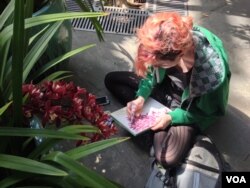America is a nation of orchid lovers. In fact, last year orchids surpassed roses as the most popular ornamental flower in the U.S.
That's no big surprise to Devin Dotson, public affairs and exhibit specialist at the U.S. Botanic Garden in Washington, where he recently helped launch a huge orchid exhibit.
"Orchids are really important in the United States," he said, "you can buy them really frequently and easily now."
That hasn't always been the case.
It wasn't until the invention of the Wardian Case in the mid-1800s that orchids and other tropical plants could be shipped around the globe. Without these miniature portable greenhouses, the delicate flowers would never have been able to survive the difficult journeys across the ocean.
Now orchids bloom on every continent except Antarctica, and are the world's largest plant family, delighting millions of people with their amazing diversity of forms and colors.
Orchids in focus
Thousands of the natural beauties are now on display at the U.S. Botanic Garden, which presents an orchid show every year in partnership with Smithsonian Gardens, which is also in Washington.
"Between the two of us, we have some of the largest orchid collections in the U.S." Dotson bragged. "So for about two months, you're going to be able to walk through the conservatory and see thousands of orchids in bloom ... from very big and showy ones ... to very small and minute ones."
On a recent spring-like day, the vibrant flowers were, indeed, center stage as visitors young and old gathered to admire, take pictures, pose for selfies and even pull out their sketch books.
Each year, the garden explores a different theme. The focus this year is how orchids have been used as inspiration for photographers and artists over the past centuries.
"We have a long history of seeing orchids in artworks from many people around the world; from Asia, to the new world, to here in the Americas," Dotson explained.
Among the photographs on display in the exhibit hall is a series on pollinators, highlighting a different aspect of the flowers.
"So we have pictures of butterflies and moths, bumble bees, flies, different pollinators," Dotson said, pointing to photos of different orchids. "Whereas normally you're really focused just on the flower, this really celebrates how we get more of those orchid flowers through that pollination story."
The exhibit is also set up so visitors can take their own pictures. In the main conservatory, a 12-foot-tall green wall, filled with colorful orchids, serves as an inviting backdrop for group photos or selfies, and offers a chance for photographers to get close-up shots of the flowers.
"We know when people come for the orchid show they're very excited," Dotson said. "They love how orchids can be so visually stunning, and so we've presented some really cool opportunities for them to photograph the plants in very naturalistic settings."
Inspiring joy
Ernest McNeill, an artist from Washington, is one of those excited visitors at the orchid wall. He says he frequently visits the garden for inspiration.
"I love orchids ... and I love doing paintings of something that is rare," he said, adding, "If you take a look at some at these small orchids, to do a painting of it just brings it to the public's eye and that is something I enjoy doing."
Mary Pritschau says she's visiting the exhibit to see the purple orchids, because that's her favorite color.
"Usually the big ones are flashy and spectacular, and there's the tiny, little spidery-shaped ones; pretty amazing that there can be so much variety all within the same type of plant," she said.
Art student Angela Pagan sits on the floor near a cluster of orchids, replicating the rust-colored flowers with pencil and pad.
"The orchids were so colorful and really nice to look at, so of all the exhibits in the building, this one seemed really nice to draw," she said.
"Orchids obviously have a long history of aesthetic beauty; people love the way they look, but it's a lot more than that," Dotson observed. "So we really celebrate these unique plants as part of this show, and we hope it's a way that people can really just engage with plants and appreciate the beauty and importance of plants in another way."













